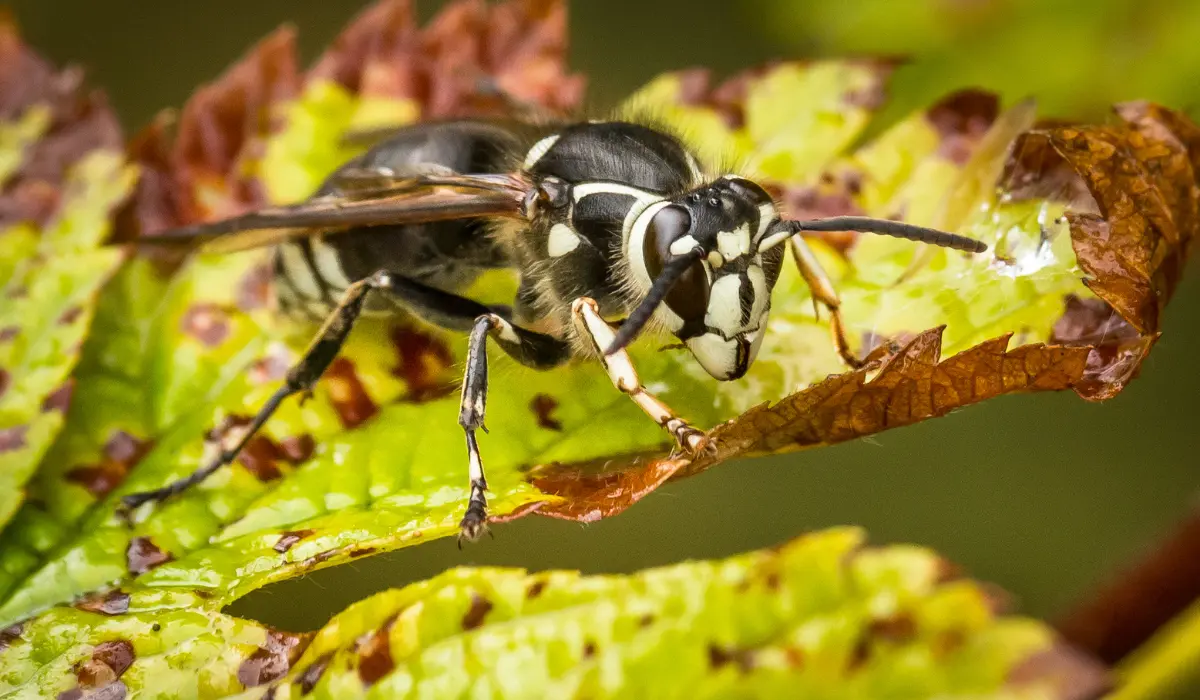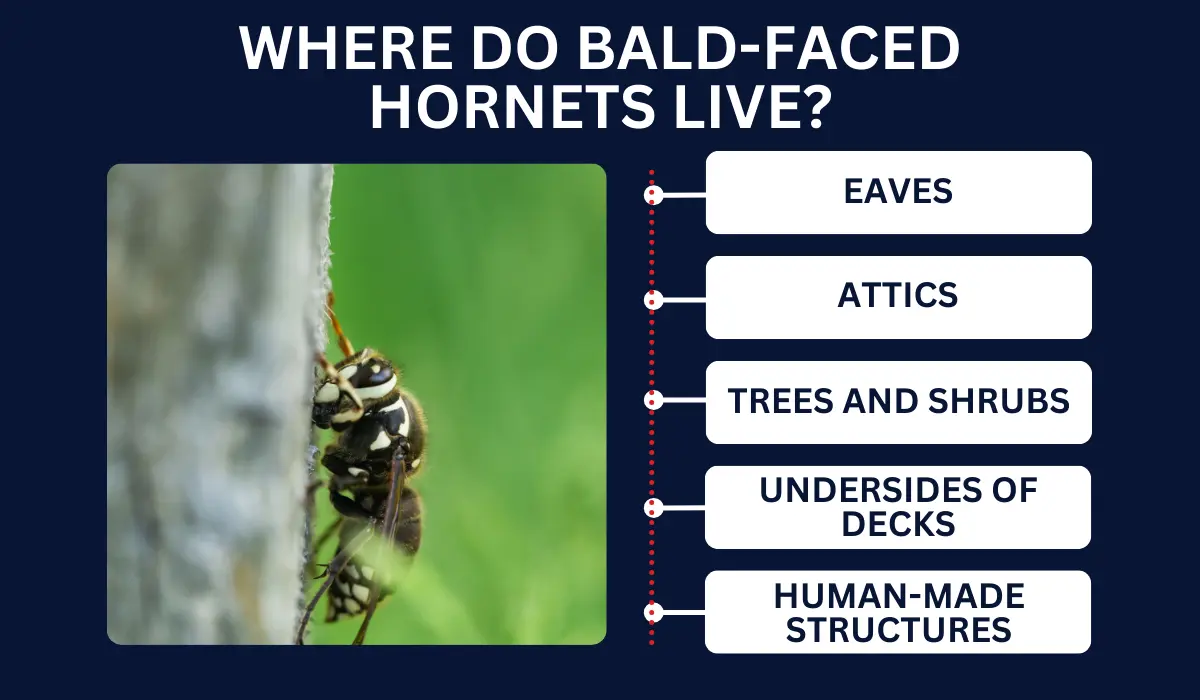
Bald-faced hornets in Louisiana have become a common concern for residents, especially during the warmer months.
These insects, known for their aggressive behavior and painful stings, can create large paper nests that threaten anyone nearby.
Why are bald-faced hornets particularly troublesome in Louisiana? Keep reading to discover critical tips and strategies for dealing with these pests effectively.
Key Takeaways
- Bald-faced hornets, identifiable by their black bodies and white faces, can be quite aggressive, especially when their nests are disturbed.
- To prevent infestations, regularly inspect your property, remove potential nesting sites, and seal any cracks or gaps that might provide access.
- For large or hazardous infestations, particularly near high-traffic areas, it’s advisable to contact professional pest control services for safe removal.
WHAT ARE BALD-FACED HORNETS?
Bald-faced hornets are easily recognizable from other wasp species. They belong to the Vespidae family and have a distinct appearance and behavior.
Physical Characteristics
Bald-faced hornets have some unique physical characteristics, making them stand out amongst other hornets. Besides their white faces and black bodies, other distinct attributes include:
| Attributes | Description |
|---|---|
| Size | Up to 0.75 to 1 inch in length |
| Body | Black with white markings |
| Eyes | Large compound eyes with multiple facets |
| Antennae | Long, segmented |
| Wing Color | Dark-tinted |
| Stinger | Smooth, capable of multiple uses |
| Mandibles | Comes in a pair, toothed and sharp |
Behavior and Life Cycle
Bald-faced hornets exhibit interesting behavior within the colony and a distinct life cycle. Key aspects include:
- Early Spring: The queen emerges from overwintering, starts building a nest, and lays the first batch of eggs.
- Late Spring: Eggs hatch into larvae, which the queen feeds until they pupate into worker hornets.
- Summer: Workers take over, expanding the nest and caring for new larvae; the queen continues laying eggs.
- Late Summer: The colony reaches peak size; new queens and male hornets are produced.
- Fall: New queens mate and then find places to hibernate; the colony declines as workers, and the old queen dies.
- Winter: The nest is abandoned; fertilized queens overwinter to restart the cycle in spring.
WHERE DO BALD-FACED HORNETS LIVE?

Bald-faced hornets prefer forested environments. However, they can also be found in urban and suburban areas, especially near human structures that offer suitable nesting sites.
They construct their nests from wood fibers, forming a papery structure. These hornets favor secluded spots, such as:
- Eaves
- Attics
- Trees and Shrubs
- Undersides of Decks
- Human-Made Structures
Role in the Ecosystem
While they can be a nuisance, bald-faced hornets are beneficial insects in the ecosystem. They contribute by:
- Preying on caterpillars and other pests: Reduces crop damage.
- Pollination: Though not primary pollinators, they occasionally help.
- Nutrient recycling: By breaking down wood fibers for nest-building.
ARE BALD-FACED HORNETS A PROBLEM?
Bald-faced hornets are known for their highly aggressive behavior, especially when their nests are disturbed. Unlike honeybees, they don’t hesitate to attack in large numbers.
Their aggression typically increases in late summer when the colonies peak. These hornets will actively defend their nests built on and around human structures.
This can make any encounter with them particularly hazardous, leading to multiple stings in a single encounter.
Bald-faced hornet stings are excruciating and can cause severe allergic reactions, especially for people allergic to bee stings.
HOW TO KEEP YOUR HOME HORNET-FREE
Inspect Your Property Regularly
Bald-faced hornets are aggressive, necessitating bi-weekly inspections to prevent infestations. Check areas like outbuildings, trees, eaves, attics, and sheds using a flashlight and ladder. If you find a nest, contact an exterminator immediately.
Remove Potential Nesting Sites
Hornets seek out secluded, covered areas to build their nests. Removing these sites reduces the likelihood of an infestation. Here’s what you need to do:
- Remove piles of leaves, wood, or compost.
- Keep shrubs and trees well-trimmed.
- Clean gutters regularly.
- Clean and inspect window frames.
Keep Lids Tight on Trash Cans
Hornets are attracted to food, and open trash cans are a perfect invitation. Properly secure your trash cans by following these tips:
| Tips | Recommended Action |
|---|---|
| Lid Type | Choose cans with snap-on lids. |
| Storage Location | Keep cans away from entry points. |
| Cleaning Routine | Clean cans weekly to remove food debris. |
Seal Any Cracks or Gaps
Small openings in your home can provide entry points for hornets. Sealing these gaps will keep them outside.
Inspect your home’s exterior and seal any gaps or cracks with any of the following:
- Apply caulk around windows and doors.
- Use weatherstripping for door frames.
- Regularly check for new gaps.
- Hire an exterminator if infestations persist.
WHEN TO CALL A PEST CONTROL PROFESSIONAL
If you notice a large bald-faced hornet nest near high-traffic areas like doorways or patios, it’s time to call the pest control experts. These areas increase the risk of stings, especially around children and pets.
Whether you’re in Baton Rouge or New Orleans, seeking expert help should be easy. For immediate intervention for a severe infestation, let Lajaunie’s wasp & hornet control specialists tailor a solution that’s right for your home.
For more information about the areas we service, visit our location page.